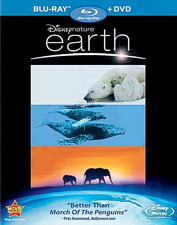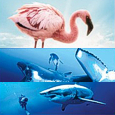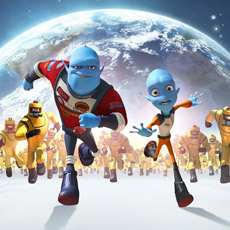Disneynature Films (April 22 2009), Walt Disney Home Entertainment (September 1 2009), 1 BD + 1 DVD, 90 mins plus supplements, 1080p high definition 1.78:1, DTS-HD and 5.1 Dolby Digital, Rated G, Retail: $39.99
Storyboard:
It’s the “March Of The Animals” as the House of Mouse returns to the natural world for the first in a new series of True Life Adventures styled wildlife films, this one following a year in the lives of animals who live in the extreme climates of our world.
The Sweatbox Review:
There’s something very familiar about The Walt Disney Studio’s return to live-action wildlife motion picture making. Walt himself was a groundbreaker, of course, launching the True Life Adventures series at a time when distributors were adamantly against releasing such footage to theaters. Walt, frustrated with the lack of support in his deal with RKO Radio Pictures, did what he always did: he went out on his own, founding the Buena Vista Pictures Distribution Co. in order to get the first of his animal films, Seal Island, onto screens in 1948. As happened so often during his career, Walt was proved right; not only was Seal Island of great popularity and interest with audiences, it also picked up awards for Best Short Subject at the Academy Awards and the Cannes Film Festival. Over at RKO, Walt’s contract eventually ran out in 1953, and it can be no coincidence that the Studio faltered and failed soon afterwards, with a series of bad business decisions that couldn’t rest back on the distribution fees the Disney films brought in.
Nature filmmaking had been around before the True Life Adventures, of course, but Disney’s films put his usual entertaining spin on what could often come over as fascinating but dull footage in the genre. Walt also injected higher values in the mostly, until then, black and white approach, adding color and budgets that allowed the cinematographers the time they needed to sit out for weeks and sometimes months in order to get the footage they needed to tell a story. Not that the animals were manipulated in any way to get them to perform to a script, but Walt wasn’t adverse to taking the odd liberty with the footage, adding narration, music and sound effects to shape the scenes so as to feel as if we were following a particular creature in their habitat, even if they became characters with story arcs in any given production.
The True Life Adventures became the bar against which other natural filmmakers were measured, and were a source of inspiration to many. Later known as the master of disaster, producer-director Irwin Allen entered the genre in 1953 with the one hour The Sea Around Us, the same year in which Walt swapped the two-reeler approach for features too, with the still amazing The Vanishing Prairie. Allen only produced one other such film, The Animal World, before heading off into special effects filled fantasies, but Disney’s unit continued for years to come, covering much of our planet in a number of highly regarded shorts and features. Television was perhaps a more natural home for these films, and its arrival signified the end of the original Adventures, which changed tact to become the True Life Fantasies, where the same high level of nature footage could be supplemented with more and more controlled filming in order to create story-driven animal films.
On television, the work of now Sir David Attenborough and the BBC Natural History Unit was second to none. A (no pun intended) natural way with the camera, an obvious enthusiasm not only for the creatures but for the resulting material as well, Attenborough has continued to brake new ground since the 1950s, particularly with such series as Life On Earth, The Living Planet and The Trials Of Life. Disney Studios returned to their original wildlife archives one last time for the 1975 compilation The Best Of Walt Disney’s True Life Adventures, and kept those original films running sporadically on TV for years afterwards. At the turn of the millennium, a short run of Disney’s New True Life Adventures all but came and went without much fanfare or recognition, the work of Attenborough and the BBC clearly being the crews at the forefront of these efforts.
With the arrival of high definition, these films took on a new depth, and in his retiring years he has seen a new generation of observers pick up the baton and run with it, producing such recent wonders as The Blue Planet and Planet Earth. The enormous success of Warner Brothers’ feature film documentary The March Of The Penguins can not be underestimated also, and the Studio that was once home to animals all over the world was caught off guard. The result was the announcement of Disneynature, a new division of the company that will look to release one feature length wildlife film per year. It’s great to see the new Disney attempting to return to its roots; a move back into natural filmmaking provides another avenue for the Studio to stretch out, simultaneously juicing up some company synergy with their Animal Kingdom theme park and bringing something new to screens while honoring their heritage.
At least it would be new if this initial foray hadn’t taken everything lock, stock and barrel from the BBC’s Planet Earth series. Shot in high definition, the series has already been seen in various versions on television, with alternate narrators in different territories, and indeed this very film edition was released to European theaters two years ago in a slightly alternate cut once again (and narrated by Patrick Stewart). Undergoing yet another reformatting, it’s been vastly tailored to the March Of The Penguins-loving American market, and although one might have been wowed by the original program, this mixture of previously seen material and March Of The Penguins styled handling offers up an experience of extreme déjà vu. We even get the same kind of deep, rumbling voiceover, provided here by James Earl Jones stepping in for Penguins’ Morgan Freeman.
Of course to new audiences – and the film’s impressive $30 million or so box office take suggests there were a fair few – there’s a lot to be bowled over by here. Whatever the film’s genesis, a good crew can’t really go wrong in making our world look spectacular on screen, and the Disney touch, as supervised by long-time Studio producer Don Hahn, is in evidence in the selections of footage that has made this edition. This transpires to hold good and not so good aspects: Attenborough always made a point of explaining things in layman’s terms, but much of the dialogue here, while sometimes repeating Planet Earth’s lines verbatim, feels a little more simplified for younger ears, which doesn’t seem to take into account children’s very apt ability to accept and understand more mature words. And, unlike its parent series, death itself is only hinted at; we never really see the results of anything truly unpleasant and even a cheetah’s pursuit of a gazelle is eventually cut away from.
As Attenborough’s replacement, Jones’ voice is warm and enthusiastic and, even if the choice has obviously been Freeman inspired, Jones doesn’t bring the Freeman cynicism that always seemed to keep him a step removed from March Of The Penguins’ onscreen goings on. But where Earth really shines is naturally in the visuals, the many instances of time-lapse photography being particularly amazing. Running through the seasons from winter to fall, spying on various groups of animals, it’s almost like a “Planet Earth greatest hits”, retaining the more awe inspiring scenes and – again for a film bearing the Disney name – moments with a high cute factor. A family of polar bears, a herd of African elephants and a couple of humpback whales get specific screentime, but this is more a sampling of our animal world rather than an in-depth exploration, although thankfully there is never an overt attempt to turn this into a “message movie” and the environmental climate aspect is never labored over.
With shooting times for these projects sometimes taking as much as several years, it’s understandable that the company would wish to draw upon others’ work in order to have something in theaters sooner rather than later, and it does make sense to team with the BBC and Discovery, obviously both proven documentary leaders in this field. But for those that have seen Earth in its original longer form, there is a sense that this is a reconfiguration rather than a particularly strong start for the Disneynature label, which might have been better off finding its own identity. However, I am sure that further collaborations may yet yield results that are more appropriately unique to the Disneynature unit and focus more on specific aspects. In the meantime, Earth provides some stunning sights and remains vastly impressive on its own terms.
Is This Thing Loaded?
Though not exactly packed with extras at first sight, Earth on Blu-ray Disc actually delivers a very nice supplemental experience. A now-regular Disney Blu-ray and DVD combo package, the standard DVD opens with previews for Snow White and Tinker Bell And The Lost Treasure, with others available from the Sneak Peek menu. Looking forward to what’s coming next in the Disneynature line, we’re treated to a neat trailer for Oceans, which pays tribute to Walt’s True Life Adventures and suggests that the Studio is aiming to have a new nature movie in theaters for each Earth Day. It doesn’t appear to be connected to other recent television explorations of the deep, which bodes well for original footage in the Disneynature line, and more enticingly it has been shot specifically for the 2.35:1 theatrical ratio, which will be quite a sight to see on the big screen.
On Blu-ray Disc as well as the DVD is the extensive documentary Earth Diaries, a 42 minute look at how some of the footage was filmed by crews all over the world. Unlike the main feature, this features a good amount of fresh material, with directors Alastair Fothergill and Mark Linfield speaking specifically about Earth the movie and not Planet Earth the series. As such, it marks this out as being something newly generated for this release, even if as before it’s a BBC production, and does a good and often humorous job of showing just how much is at risk in heading out into the great outdoors in order to capture the material needed to put a coherent production together. The only thing marring the inclusion is some of the PAL to NTSC conversion: it’s one of the more unfortunate I’ve seen, with blurred frames and soft in appearance, even on Blu-ray, where it is presented in standard definition.
Exclusive to the Blu-ray Disc is Filmmaker Annotations, essentially an onscreen trivia track-styled written commentary by directors Fothergill and Linfield, which apparently runs the length of the feature. I say apparently, because whenever I asked my player to switch into this mode, it went into meltdown and wouldn’t play the disc! This is the first such BD title that I’ve had any problems with, and you may want to check your own copies fresh out of the case to make sure there are no other defects, but I’m sure there is much information to be discovered if you can get this track working!
Case Study:
Forgoing the often redundant Digital Copy disc, Earth comes to Blu-ray in a pretty standard blue keepcase, with the BD and DVD discs slotted on the inside of each side of the case rather than in an extra tray. The sleeve artwork is replicated on a slipcover, which is nice ‘n’ shiny and brings a level of prestige to the release, though I’m not sure if Earth is “better than March Of The Penguins” as the press quote exclaims, as it’s simply a different beast, though one can understand Disney’s wanting to remind the audience of that film and make the connection. Inside we get the usual Disney BD flyer and Rewards code, but the sleeve insert lacks a Scene Selection listing, going for a handful of stills instead.
Ink And Paint:
More so than any CGI-heavy blockbuster event movie, the sights in Earth can all be relied on to be the real deal, and the pin-sharp high definition cinematography captures all the detail with astonishing accuracy. With such a clean and stunning source to begin with, even the regular DVD contains an image of dazzling clarity and depth, even if it is unsurprisingly beaten by the BD’s beauty. Of course, those with the Planet Earth collection will have seen most of this before, and for a more enveloping experience that set can not be faulted. As mentioned above, this edition is more lightweight, but the textures to be found in the locations might just make you think you’re there. Despite all the wonderful animation and effects-driven sights seen recently on the Blu format, this is what demo discs are made of, offering amazing layers of imagery unimaginable until now and far surpassing the often grainy 16mm of March Of The Penguins. I may sound like I’m overselling this, but just wait until you see it!
Scratch Tracks:
Although the filmmakers do indeed record wildtracks and specific creatures’ natural sound movements, a well-kept secret in natural history documenting is the use of audio effects to convey the sounds that sometimes just can not be recorded. As such, and coupled with a lushly recorded orchestral score by George Fenton and James Earl Jones’ booming vocal narration, Earth boasts a detailed, layered soundtrack despite what might be considered simple elements. This cut of the material may well appeal more to families with younger children than the original long-form series, and for the most part Fenton’s score has been kept intact, apart from some Disney incursions, most notably an African chorus, which could again be a mark of Lion King producer Hahn’s supervising efforts. The chorus doesn’t quite gel with the rest of the score, which would have been most welcome as an isolated option in its own right, and feels like a little bit of a lazy choice, but the discs reproduce each high and low in the music and natural sounds with crystal clarity. Uniquely, the DVD asks up front which language one would like it to play in, the options of English, French, Spanish or Portuguese serving up the contents in a variety of dubbed and subbed options, while the BD has English, French and Spanish options only.
Final Cut:
Although I knew before sitting down to watch Earth that it had been compiled from the Planet Earth series, I was expecting a little more from Disneynature’s first foray back into wildlife films. For new audiences that didn’t catch the series on TV, there is much to marvel at here, though one may or may not agree with the decision to Disneyfy the content for younger eyes and ears. The result is a more narrative driven storyline, which ultimately does work for this configuration, and Earth never claims to be out to replace its parent series and does indeed note the connection in the credits. As the first in a series, it should wow newcomers to this kind of material, which is the main thing, and I am looking forward to seeing how the label progresses and, hopefully, starts to produce its own exclusive material. As a high-def experience, this is a chance for parents to open their children’s eyes to non-animated Disney product and perhaps for the next David Attenborough to be inspired to continue the long lineage of nature films into the future.
 | ||
 |









